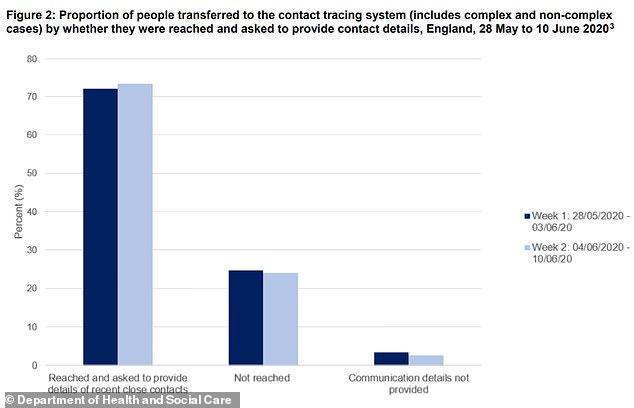Almost 90,000 people in England were told to self-isolate in the first two weeks of the NHS test and trace scheme designed to keep a lid on the coronavirus outbreak.
Department of Health data today revealed that a total of 87,639 people have been contacted and asked to stay at home because they might have Covid-19.
England’s system has been up and running since May 28 and has had to trace people who have been in close contact with one of 14,045 confirmed coronavirus patients.
But thousands of people are still flying under the system’s radar, with tracers unable to reach 27.4 per cent of all at-risk contacts so far – a total 3,853 people.
And one in 10 of their contacts (9.4 per cent) were also unable to be contacted, meaning some 9,107 people were either unaware they might be infected or ignored contact tracing staff.
The Labour Party called this ‘hugely worrying’ and said large proportions of at-risk people slipping through the net was a ‘gaping hole’ in the UK’s Covid-19 strategy.
Statistics for the week from June 4 and June 10, published today, showed that 44,895 contacts were identified, meaning the army of 25,000 contact tracing staff had to phone, on average, two people each over the course of an entire week.
One tracer told MailOnline she had phoned only one person in a month of working in the system and that some people had so little to do that they went home in the middle of the day and returned to the call centre in the evening to log off.
Dido Harding, who is in charge of the service, last week admitted it was ‘not yet at the gold standard’ but said it would improve over time.
The data for the first week, from May 28 to June 3, has also been revised and the number of people contacted soared from just 27,000 to 47,000.
This suggests the average number of contacts people are having is rising as lockdown rules continue to loosen, with people in the first week coming into contact with an average 8.9 people each and those in the second week 10.2 people each.
Tracers attempt to contact someone 10 times within the first 24 hours of receiving their details and use phone calls, texts and emails to try and get through.
Scotland, Wales and Northern Ireland all have their own contact tracing systems up and running but deal with significantly smaller numbers of people.
More than a quarter of people diagnosed with the coronavirus could not be got hold of by contact tracing staff in the first two weeks of the test and trace system’s operation, Department of Health statistics show
Baroness Harding said today: ‘NHS Test and Trace is working to stop the spread of coronavirus and undoubtedly helping to save lives.
‘Building on our previous work, this week’s data shows that tens of thousands more people who may have otherwise unwittingly spread the virus are now remaining safely at home.
‘We continue to rely on everyone to play their part and we urge those with symptoms to book a test immediately, and those contacted by the NHS Test and Trace service to follow the advice they receive.’
Today’s statistics show that 4,366 people with confirmed coronavirus were contacted by test and trace and gave details of 44,895 people they had met.
This was an average of 10.2 people each – every 10 people came into contact with 102 others – which rose from 8.9 each among the 5,826 people diagnosed between May 28 and June 3.
People are coming into contact with increasing numbers of people, this data suggests, as lockdown continues to ease.
Growing numbers of people are returning to work, travelling to meet friends and family and going out shopping as the virus continues to fade across the UK.
The contact tracing systems seems busy – contacting almost 100,000 people in a fortnight – but this averages just two people per week for each of the 25,000 tracers.
Fewer people are being diagnosed with the virus – the number of patients referred to the system dropped by 2,000 in just one week – but they are having more contacts.
There are concerns the tracing system is not successfully reaching enough people.
One out of 10 of the at-risk contacts could not be reached by tracing staff – 9,107 out of 96,746 so far.
And a quarter of the coronavirus patients themselves – 3,435 out of 14,045 (24.5 per cent) – also did not respond to approaches from test and trace.
Labour’s shadow health minister and MP for Ellesmere Port, Justin Madders, said: ‘Expert opinion shows that to defeat this virus we need a fully functioning test and trace system, so these latest figures are hugely worrying.
‘Having a quarter of those who test positive not contacted is a gaping hole in the system that urgently needs to be addressed.
‘And questions still remain about how the app was hailed as a vital part of the system at the outset, but is now just the “cherry on the cake”.
‘Ministers need to level with the public about how they are going to tackle these real and serious issues as a matter of urgency.’
Baroness Harding and Professor John Newton, from Public Health England, last week explained that they did not expect to be able to contact everyone, for a variety of reasons.
‘We won’t have got all of the contacts,’ Baroness Harding said. ‘Some were unreachable, some didn’t want to provide contacts, some said “well, I’ve already told my mates I tested positive”.’
People may not have phone numbers for those they had contacted, the health chiefs explained, or the contact details they gave might be wrong.
Other people simply would not pick up the phone or respond to attempts to contact, while others did not want to engage with the system and refused to co-operate.


People refusing to help are a tiny minority, Baroness Harding and Professor Newton said, but the Department of Health does not give exact data to back this up.
Health Secretary Matt Hancock last week said he was pleased with how the programme was going so far and urged people to do their ‘civic duty’ and use the test and trace system if it reached out to them.
The system was supposed to come with a mobile app which would do a lot of the contact tracing work automatically.
It would work using Bluetooth to confirm who people had come into close contact with before they tested positive for the coronavirus.
But the app, originally scheduled for release in mid-May, has been beset with controversy and may now not be ready until the winter.
Health minister James Bethell yesterday told Parliament’s Science and Technology Committee the app was no longer the Government’s priority.
He said: ‘We’re seeking to get something for the winter, but it isn’t a priority for us at the moment.’
Lord Bethell, a member of the House of Lords and minister for innovation at the Department of Health, explained: ‘The pilot [of the app] on the Isle of Wight has gone very well indeed and it has led to some infections being avoided.
‘But one of the things it taught us is that it is the human contact that is most valued by people.
‘There is a danger of being too technological and relying too much on texts and emails and alienating people because you’re telling them quite alarming news through quite casual communication.
‘Whereas [the] call centres we’ve put together have actually worked extremely well. So that is where our focus is at the moment.’
England’s contact tracing system is the largest one in operation in the UK but Scotland, Wales and Northern Ireland all have their own programmes in place.
Scotland’s Test and Protect was launched on May 28 and, up to June 14, had traced 1,239 contacts from 992 Covid-19 positive patients.
Test, Trace, Protect in Wales started on June 1 and, in its first two weeks, traced 1,553 contacts from 1,309 positive cases.
Its success rate for reaching the at-risk contacts has been 88.6 per cent, compared to England’s 90.6 per cent.
Northern Ireland’s contact tracing system is run by its Public Health Agency and has been operating since the middle of May.
In its most recent data, covering June 4 to June 10, the PHA showed it had reached out to 146 out of 167 contacts (87.4 per cent) from 81 positive cases (101 were referred but only 80 per cent completed the process).
Data for the English system, published today by the Department of Health, has revised the statistics that were put out last week and increased the numbers dramatically.
Last week officials said 26,985 out of 31,794 contacts had been successfully reached and asked to self-isolate after discussions with 5,407 confirmed Covid-19 cases.
This has now been upgraded to 44,895 contacts out of a total 51,851 from 5,826 coronavirus patients.
The updated numbers improve the performance of the system slightly, with the success rate for contact tracing rising from 84.5 per cent to 86.5 per cent.
And the success rate for contacting confirmed patients also rose from 67 per cent to 72 per cent as a result of the revised data.
Explaining the new numbers, the Department of Health said some contact tracing was still incomplete by the time the data was collected, meaning thousands of people were not counted until the process finished after the report was published.
It said: ‘The figures presented are based on a data cut a number of days after the end of the reporting period, to give time for cases reported towards the end of the 7-day period to have an outcome.
‘Some cases may continue to be in progress after this period, and therefore data may need to be revised over time.’

